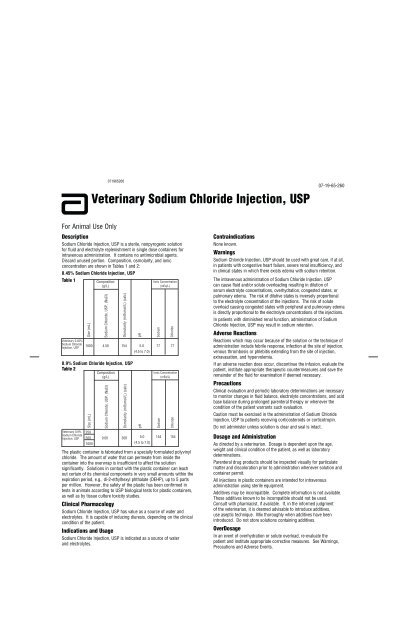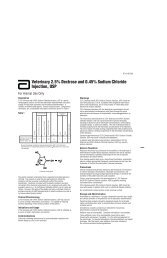Veterinary 0.9% Sodium Chloride Injection, USP - Abbott Animal ...
Veterinary 0.9% Sodium Chloride Injection, USP - Abbott Animal ...
Veterinary 0.9% Sodium Chloride Injection, USP - Abbott Animal ...
You also want an ePaper? Increase the reach of your titles
YUMPU automatically turns print PDFs into web optimized ePapers that Google loves.
For <strong>Animal</strong> Use Only<br />
<strong>Veterinary</strong> <strong>Sodium</strong> <strong>Chloride</strong> <strong>Injection</strong>, <strong>USP</strong><br />
Description<br />
<strong>Sodium</strong> <strong>Chloride</strong> <strong>Injection</strong>, <strong>USP</strong> is a sterile, nonpyrogenic solution<br />
for fluid and electrolyte replenishment in single dose containers for<br />
intravenous administration. It contains no antimicrobial agents.<br />
Discard unused portion. Composition, osmolarity, and ionic<br />
concentration are shown in Tables 1 and 2:<br />
0.45% <strong>Sodium</strong> <strong>Chloride</strong> <strong>Injection</strong>, <strong>USP</strong><br />
Table 1<br />
<strong>Veterinary</strong> 0.45%<br />
<strong>Sodium</strong> <strong>Chloride</strong><br />
<strong>Injection</strong>, <strong>USP</strong><br />
Size (mL)<br />
Composition<br />
(g/L)<br />
<strong>Sodium</strong> <strong>Chloride</strong>, <strong>USP</strong>, (NaCl)<br />
071965260<br />
1000 4.50 154<br />
<strong>0.9%</strong> <strong>Sodium</strong> <strong>Chloride</strong> <strong>Injection</strong>, <strong>USP</strong><br />
Table 2<br />
Composition<br />
(g/L)<br />
Size (mL)<br />
<strong>Sodium</strong> <strong>Chloride</strong>, <strong>USP</strong>, (NaCl)<br />
Osmolarity (mOsmol/L) (calc)<br />
Osmolarity (mOsmol/L) (calc)<br />
<strong>Veterinary</strong> <strong>0.9%</strong> 250<br />
<strong>Sodium</strong> <strong>Chloride</strong><br />
<strong>Injection</strong>, <strong>USP</strong> 500 9.00 308<br />
1000<br />
Ionic Concentration<br />
(mEq/L)<br />
5.0 77 77<br />
(4.5 to 7.0)<br />
The plastic container is fabricated from a specially formulated polyvinyl<br />
chloride. The amount of water that can permeate from inside the<br />
container into the overwrap is insufficient to affect the solution<br />
significantly. Solutions in contact with the plastic container can leach<br />
out certain of its chemical components in very small amounts within the<br />
expiration period, e.g., di-2-ethylhexyl phthalate (DEHP), up to 5 parts<br />
per million. However, the safety of the plastic has been confirmed in<br />
tests in animals according to <strong>USP</strong> biological tests for plastic containers,<br />
as well as by tissue culture toxicity studies.<br />
Clinical Pharmacology<br />
<strong>Sodium</strong> <strong>Chloride</strong> <strong>Injection</strong>, <strong>USP</strong> has value as a source of water and<br />
electrolytes. It is capable of inducing diuresis, depending on the clinical<br />
condition of the patient.<br />
Indications and Usage<br />
<strong>Sodium</strong> <strong>Chloride</strong> <strong>Injection</strong>, <strong>USP</strong> is indicated as a source of water<br />
and electrolytes.<br />
pH<br />
pH<br />
<strong>Sodium</strong><br />
<strong>Chloride</strong><br />
Ionic Concentration<br />
(mEq/L)<br />
<strong>Sodium</strong><br />
<strong>Chloride</strong><br />
5.0 154 154<br />
(4.5 to 7.0)<br />
07-19-65-260<br />
Contraindications<br />
None known.<br />
Warnings<br />
<strong>Sodium</strong> <strong>Chloride</strong> <strong>Injection</strong>, <strong>USP</strong> should be used with great care, if at all,<br />
in patients with congestive heart failure, severe renal insufficiency, and<br />
in clinical states in which there exists edema with sodium retention.<br />
The intravenous administration of <strong>Sodium</strong> <strong>Chloride</strong> <strong>Injection</strong>, <strong>USP</strong><br />
can cause fluid and/or solute overloading resulting in dilution of<br />
serum electrolyte concentrations, overhydration, congested states, or<br />
pulmonary edema. The risk of dilutive states is inversely proportional<br />
to the electrolyte concentration of the injections. The risk of solute<br />
overload causing congested states with peripheral and pulmonary edema<br />
is directly proportional to the electrolyte concentrations of the injections.<br />
In patients with diminished renal function, administration of <strong>Sodium</strong><br />
<strong>Chloride</strong> <strong>Injection</strong>, <strong>USP</strong> may result in sodium retention.<br />
Adverse Reactions<br />
Reactions which may occur because of the solution or the technique of<br />
administration include febrile response, infection at the site of injection,<br />
venous thrombosis or phlebitis extending from the site of injection,<br />
extravasation, and hypervolemia.<br />
If an adverse reaction does occur, discontinue the infusion, evaluate the<br />
patient, institute appropriate therapeutic countermeasures and save the<br />
remainder of the fluid for examination if deemed necessary.<br />
Precautions<br />
Clinical evaluation and periodic laboratory determinations are necessary<br />
to monitor changes in fluid balance, electrolyte concentrations, and acid<br />
base balance during prolonged parenteral therapy or whenever the<br />
condition of the patient warrants such evaluation.<br />
Caution must be exercised in the administration of <strong>Sodium</strong> <strong>Chloride</strong><br />
<strong>Injection</strong>, <strong>USP</strong> to patients receiving corticosteroids or corticotropin.<br />
Do not administer unless solution is clear and seal is intact.<br />
Dosage and Administration<br />
As directed by a veterinarian. Dosage is dependent upon the age,<br />
weight and clinical condition of the patient, as well as laboratory<br />
determinations.<br />
Parenteral drug products should be inspected visually for particulate<br />
matter and discoloration prior to administration whenever solution and<br />
container permit.<br />
All injections in plastic containers are intended for intravenous<br />
administration using sterile equipment.<br />
Additives may be incompatible. Complete information is not available.<br />
Those additives known to be incompatible should not be used.<br />
Consult with pharmacist, if available. If, in the informed judgment<br />
of the veterinarian, it is deemed advisable to introduce additives,<br />
use aseptic technique. Mix thoroughly when additives have been<br />
introduced. Do not store solutions containing additives.<br />
OverDosage<br />
In an event of overhydration or solute overload, re-evaluate the<br />
patient and institute appropriate corrective measures. See Warnings,<br />
Precautions and Adverse Events.
How Supplied<br />
The available sizes of each injection in plastic containers are shown<br />
below:<br />
Size<br />
List Numbers (mL) Code NDC Product Name<br />
04922-04-10 1000 2B8204 00074-4922-10 0.45% <strong>Sodium</strong> <strong>Chloride</strong><br />
<strong>Injection</strong>, <strong>USP</strong><br />
04925-04-02 250 2B8202 00074-4925-02 <strong>0.9%</strong> <strong>Sodium</strong> <strong>Chloride</strong><br />
04925-04-05 500 2B8203 00074-4925-05 <strong>Injection</strong>, <strong>USP</strong><br />
04925-04-10 1000 2B8214 00074-4925-10<br />
Exposure of pharmaceutical products to heat should be minimized.<br />
Avoid excessive heat. It is recommended the product be stored at<br />
room temperature (25°C/77°F); brief exposure up to 40°C/104°F<br />
does not adversely affect the product.<br />
Directions for use of plastic container<br />
To Open<br />
Tear overwrap down side at slit and remove solution container.<br />
Some opacity of the plastic due to moisture absorption during the<br />
sterilization process may be observed. This is normal and does not<br />
affect the solution quality or safety. The opacity will diminish gradually.<br />
Check for minute leaks by squeezing inner bag firmly. If leaks are<br />
found, discard solution as sterility may be impaired. If supplemental<br />
medication is desired, follow directions below.<br />
Preparation for Administration<br />
1. Suspend container from eyelet support.<br />
2. Remove protector from outlet port at bottom of container.<br />
3. Attach administration set. Refer to complete directions<br />
accompanying set.<br />
Manufactured for:<br />
<strong>Abbott</strong> Laboratories<br />
North Chicago, IL 60064<br />
For customer service call (888) 299-7416<br />
Printed in USA<br />
*BAR CODE POSITION ONLY<br />
071965260<br />
To Add Medication<br />
WARNING: Additives may be incompatible.<br />
To add medication before solution administration<br />
1. Prepare medication site.<br />
2. Using syringe with 19 to 22 gauge needle, puncture resealable<br />
medication port and inject.<br />
3. Mix solution and medication thoroughly. For high density<br />
medication such as potassium chloride, squeeze ports while ports<br />
are upright and mix thoroughly.<br />
To add medication during solution administration<br />
1. Close clamp on the set.<br />
2. Prepare medication site.<br />
3. Using syringe with 19 to 22 gauge needle, puncture resealable<br />
medication port and inject.<br />
4. Remove container from IV pole and/or turn to an upright position.<br />
5. Evacuate both ports by squeezing them while container is in the<br />
upright position.<br />
6. Mix solution and medication thoroughly.<br />
7. Return container to in-use position and continue administration.<br />
CAUTION: Federal law restricts this drug to use by or on the<br />
order of a licensed veterinarian.<br />
07-19-65-260<br />
Rev. September 2010



